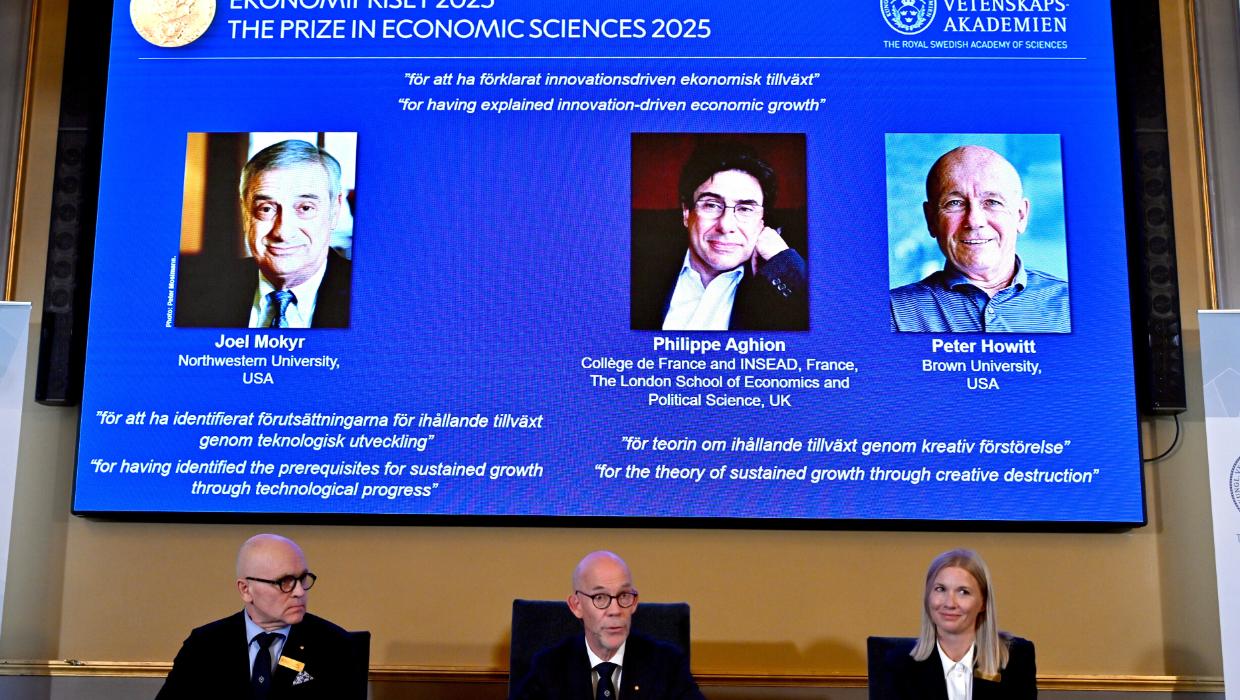Science
Economists Awarded Nobel for Insights on Creative Destruction

Three distinguished economists have been awarded the Nobel Memorial Prize in Economic Sciences for their groundbreaking research on the dynamics of business innovation and the concept of “creative destruction.” The winners, Joel Mokyr from Northwestern University, Philippe Aghion from the Collège de France and the London School of Economics, and Peter Howitt from Brown University, received the prestigious accolade on October 9, 2023, in Stockholm.
Their research sheds light on how new products and technologies drive economic growth and enhance human welfare, often at the expense of older companies and industries. This phenomenon, termed “creative destruction,” has been a key topic in economic theory since Joseph Schumpeter introduced the concept in his seminal 1942 work, “Capitalism, Socialism and Democracy.”
Understanding Creative Destruction
The Nobel committee emphasized the importance of the laureates’ work in quantifying and elucidating the mechanisms behind creative destruction. Mokyr’s research highlighted that for innovations to thrive in a self-sustaining process, it is essential to grasp not only their functionality but also the scientific principles that support them. Meanwhile, Aghion and Howitt contributed significantly to the understanding of sustained economic growth through a complex mathematical framework they developed in a 1992 article, which provided new insights into the creative destruction model.
Examples of creative destruction are prevalent in modern society. The rise of e-commerce has significantly disrupted traditional retail, while streaming services like Netflix have rendered video rental stores obsolete. Historical instances, such as the decline of horse-drawn carriages due to the advent of the automobile, further illustrate the transformative effects of innovation.
Implications for Economic Growth
John Hassler, chair of the Nobel committee, remarked that the laureates’ findings underscore the necessity of fostering the mechanisms that drive creative destruction to avoid stagnation. Aghion and Howitt’s research indicates that markets dominated by a few large firms can stifle innovation, a concern relevant to industries like telecommunications and social media.
The economists argue for the need to support individuals adversely impacted by technological changes while facilitating their transition to more productive roles. They emphasize promoting social mobility, allowing individuals to pursue careers independent of their family backgrounds.
Mokyr has consistently advocated for a positive outlook on technological progress. He noted that while new inventions may initially displace jobs, they also create unforeseen opportunities. In a 2015 interview, he cited the music streaming service Spotify as an example of an innovation that, despite being difficult to quantify economically, offers substantial benefits to users.
The Nobel committee’s announcement comes at a time when innovation remains critical for economic competitiveness, particularly in Europe. A report by former European Central Bank head Mario Draghi highlights that Europe faces a growing productivity gap with the United States, particularly in digital technology. Aghion stressed the urgency for Europe to keep pace with innovation in the U.S. and China, advocating for enhanced research and venture capital funding to turn concepts into viable businesses.
Mokyr and Aghion also discussed the implications of artificial intelligence (AI) on future economic growth. Aghion believes that while AI holds significant potential, its impact largely depends on the institutional frameworks and policies established to regulate and promote competition within the sector. Mokyr dismissed the notion that AI poses an existential threat to humanity, instead viewing it as a powerful tool that can enhance human productivity and lead to more engaging work.
In a light-hearted moment, Mokyr recounted the surprise of receiving the Nobel Prize. Awaking early, he found numerous congratulatory messages and initially thought it was a prank. Howitt, too, experienced disbelief when he received a call from a Swedish reporter while still in bed. Aghion, who had been asked to provide contact information for his co-winners, expressed his joy at sharing the honor with such esteemed colleagues.
The Nobel Prize in Economic Sciences, officially known as the Bank of Sweden Prize in Economic Sciences in Memory of Alfred Nobel, includes a monetary award of 11 million Swedish kronor (approximately $2.02 million), with half awarded to Mokyr and the remainder shared by Aghion and Howitt. Each laureate also receives an 18-carat gold medal and a diploma.
Since its establishment in 1968, the economics prize has been awarded 57 times, recognizing a total of 99 laureates, only three of whom have been women. While some purists argue that the economics prize is not a true Nobel Prize, it is presented alongside the other Nobel Prizes on December 10, commemorating Nobel’s death in 1896.
-

 World4 months ago
World4 months agoTest Your Knowledge: Take the Herald’s Afternoon Quiz Today
-

 Sports5 months ago
Sports5 months agoPM Faces Backlash from Fans During Netball Trophy Ceremony
-

 Lifestyle5 months ago
Lifestyle5 months agoDunedin Designers Win Top Award at Hokonui Fashion Event
-

 Entertainment5 months ago
Entertainment5 months agoExperience the Excitement of ‘Chief of War’ in Oʻahu
-

 Sports5 months ago
Sports5 months agoLiam Lawson Launches New Era for Racing Bulls with Strong Start
-

 World5 months ago
World5 months agoCoalition Forms to Preserve Māori Wards in Hawke’s Bay
-

 Health5 months ago
Health5 months agoWalking Faster Offers Major Health Benefits for Older Adults
-

 Lifestyle5 months ago
Lifestyle5 months agoDisney Fan Reveals Dress Code Tips for Park Visitors
-

 Top Stories2 weeks ago
Top Stories2 weeks agoTongan Star Eli Katoa Shares Recovery Update After Surgery
-

 Politics5 months ago
Politics5 months agoScots Rally with Humor and Music to Protest Trump’s Visit
-

 Top Stories5 months ago
Top Stories5 months agoUK and India Finalize Trade Deal to Boost Economic Ties
-

 Health2 months ago
Health2 months agoRadio Host Jay-Jay Feeney’s Partner Secures Visa to Stay in NZ









